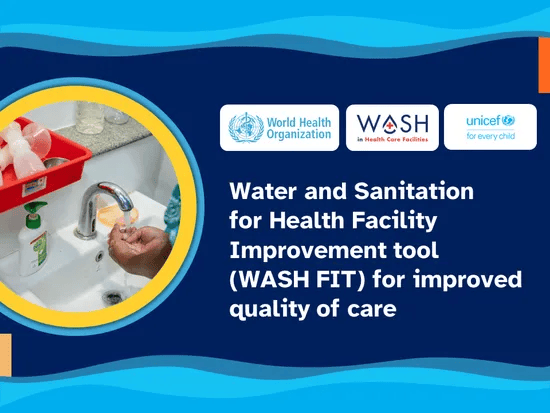
Water and Sanitation for Health Facility Improvement Tool (WASH FIT) for improved quality of care
- Identify and map key health actors and programmes and implement WASH FIT within the national context of WASH in health care facility efforts, including the WHO/UNICEF “8 practical steps”.
- Describe what WASH FIT is, know its expected impact and be able to apply it in various settings.
- Demonstrate increased technical knowledge on water and sanitation services, hand hygiene, health care waste management, environmental cleaning and gender equity disability and social inclusion (GEDSI) in health care facilities.
- Apply strategies to improve climate resiliency of health care facilities through use of WASH FIT.
- Identify enabling factors and potential barriers to implementing WASH FIT and how to overcome them.
The WHO/UNICEF Water and Sanitation for Health Facility Improvement Tool (WASH FIT) helps facilities to assess, manage and improve these critical services. This course covers the foundational concepts of WASH FIT, the methodology and examples of its application from a wide range of settings. It also includes six technical modules on water, sanitation, hand hygiene, health care waste, environmental cleaning and gender equality, disability and social inclusion (GEDSI).
This course offers comprehensive training across 13 modules. It begins with an introduction to the WASH FIT framework and looks at how WASH FIT can support systems strengthening and be integrated into key health programmes (module 1). Subsequent modules (modules 2-6) guide learners through the WASH FIT process, from establishing and training a WASH FIT team, to conducting facility assessments, undertaking a risk assessment and developing and implementing an improvement plan. Modules 7-13 cover six technical areas, based on WHO guidelines, for improving water, sanitation, hand hygiene, health care waste management, environmental cleaning and gender equality, disability and social inclusion (GEDSI) in health care facilities.
Module 13 supports learners’ efforts to roll out, adapt and scale up WASH FIT in their own national context. Country case studies are used throughout the course to illustrate what has worked in different contexts. Finally, strategies for increasing climate resiliency of health care facilities through the WASH FIT process are included throughout.
Approximate course duration: three to four hours.
Languages
This course is available in the following languages: English.
Photo credits: UNICEF/Upadhayay
Assessment & Awards
You will receive a Confirmation of Participation upon completing all the modules in this course. Please note that this award does not serve as a professional qualification.
- National Health and WASH Sector Leaders: policymakers, health regulators, infrastructure and financing officials and national planners who are involved in the development and implementation of WASH strategies in health care facilities.
- Local and District Health Authorities: local government officials, district health offices and associated technical staff such as engineers, inspectors and plumbers who support the implementation of WASH in health care facilities at the local level.
- Health Facility Managers and Staff: health care facility managers, quality improvement teams, WASH and Infection Prevention and Control (IPC) focal points and other facility-level staff engaged in improving WASH services.
Guidance note
The content of this course has been validated, verified, and is owned by the WHO Water Sanitation and Health unit. This course is not a WHO Academy co-produced course. In case of any concerns or feedback on the course content, please share your feedback in the survey form at the end of this course.
Browser and device compatibility
For the best experience, we recommend using the latest version of Chrome, Firefox, Safari, or Microsoft Edge to access the courses.
Produced by the WHO Water Sanitation and Health team.

